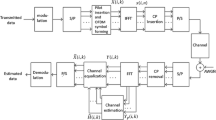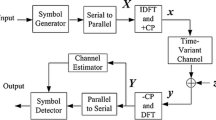Abstract
Wireless communication systems utilizing orthogonal frequency division multiplexing (OFDM) transmissions are capable of delivering high data rates over multipath frequency selective channels. This paper deals with joint estimation/interpolation of wireless channel using pilot symbols transmitted concurrently with the data. We propose a low complexity, spectrally efficient minimum mean square error channel estimator which exploits the correlation structure of channel frequency response for reducing the complexity. Specifically, it is shown that if pilots are inserted appropriately across OFDM subcarriers, the proposed algorithm requires no matrix inversion, thereby significantly relieving the computational burden without deteriorating the performance. Moreover, the knowledge of channel correlation is also not required for the proposed estimator. Simulation results validate that the proposed technique outperforms existing low-complexity variants in terms of mean square error and computational complexity.








Similar content being viewed by others
Notes
The treatment is similar for MIMO systems by assuming orthogonal training mechanism where only one antenna is active at a given pilot symbol.
References
Bölcskei, H. (2004). Principles of MIMO-OFDM wireless systems. URL http://www.nari.ee.ethz.ch/commth/pubs/p/crc03.
Cimini, L. (1985). Analysis and simulation of a digital mobile channel using orthogonal frequency division multiplexing. IEEE Transactions on Communications, 33(7), 665–675. doi:10.1109/TCOM.1985.1096357.
Crow, B., Widjaja, I., Kim, J. G., & Sakai, P. (1997). IEEE 802.11 wireless local area networks. IEEE Communications Magazine, 35(9), 116–126. doi:10.1109/35.620533.
IEEE Std 802.11. (1997). IEEE standard for Wireless LAN Medium Access Control (MAC) and Physical Layer (PHY) specifications (pp. 1–445). doi:10.1109/IEEESTD.1997.85951.
IEEE Std 802.16. (2012). IEEE standard for air interface for broadband wireless access systems (pp. 1–2542). doi:10.1109/IEEESTD.2012.6272299.
Overview of 3GPP Release 12 V0.0.3. IEEE (2012).
Jayakumari, J. (2010). MIMO-OFDM for 4G wireless systems. International Journal of Engineering Science and Technology, 2, 2886–2889.
van de Beek, J. J., Edfors, O., Sandell, M., Wilson, S., & Ola Borjesson, P. (1995). On channel estimation in OFDM systems. In 1995 IEEE 45th vehicular technology conference (Vol. 2, pp. 815–819). doi:10.1109/VETEC.1995.504981.
Lei, J., Dazhong, C., & Chunping, H. (2004). Two novel transform domain estimation methods for OFDM system and their application environment. In Canadian conference on electrical and computer engineering, 2004. (Vol. 1, pp. 377–380). doi:10.1109/CCECE.2004.1345034.
Sun, N., Ayabe, T., & Nishizaki, T. (2007). Efficient spline interpolation curve modeling. In Third international conference on intelligent information hiding and multimedia signal processing, 2007. IIHMSP 2007 (Vol. 2, pp. 59–62). doi:10.1109/IIHMSP.2007.4457653.
Wang, X., & Liu, K. (2001). OFDM channel estimation based on time-frequency polynomial model of fading multipath channel. In IEEE VTS 54th vehicular technology conference, 2001. VTC 2001 Fall (Vol. 1, pp. 460–464). doi:10.1109/VTC.2001.956641.
Hoeher, P., Kaiser, S., & Robertson, P. (1997). Two-dimensional pilot-symbol-aided channel estimation by Wiener filtering. In 1997 IEEE international conference on acoustics, speech, and signal processing, 1997. ICASSP-97 (Vol. 3, pp. 1845–1848). doi:10.1109/ICASSP.1997.598897.
Tsai, P. Y., & Chiueh, T. D. (2009). Adaptive raised-cosine channel interpolation for pilot-aided OFDM systems. IEEE Transactions on Wireless Communications, 8(2), 1028–1037. doi:10.1109/TWC.2009.080338.
Rinne, J., & Renfors, M. (1996). Pilot spacing in orthogonal frequency division multiplexing systems on practical channels. In International conference on consumer electronics, 1996. Digest of Technical Papers (p. 4). doi:10.1109/ICCE.1996.517185.
Athaudage, C. R. N., & Jayalath, A. D. S. (2003). Low-complexity channel estimation for wireless OFDM systems. In 14th IEEE proceedings on personal, indoor and mobile radio communications, 2003. PIMRC 2003 (Vol. 1, pp. 521–525). doi:10.1109/PIMRC.2003.1264326.
Weber, R. (2000). Low-complexity channel estimation for WCDMA random access. In 52nd vehicular technology conference, 2000. IEEE-VTS Fall VTC 2000 (Vol. 1, pp. 344–351).
Jiang, M., Huang, S., & Wen, W. (2012). Adaptive polar-linear interpolation aided channel estimation for wireless communication systems. IEEE Transactions on Wireless Communications, 11(3), 920–926. doi:10.1109/TWC.2012.012712.101162.
Kang, S. G., Ha, Y. M., & Joo, E. K. (2003). A comparative investigation on channel estimation algorithms for OFDM in mobile communications. IEEE Transactions on Broadcasting, 49(2), 142–149. doi:10.1109/TBC.2003.810263.
Edfors, O., Sandell, M., van de Beek, J. J., Wilson, S., & Borjesson, P. (1996). OFDM channel estimation by singular value decomposition. In IEEE 46th vehicular technology conference, 1996. Mobile technology for the human race (Vol. 2, pp. 923–927). doi:10.1109/VETEC.1996.501446.
Hammarberg, P., & Edfors, O. (2006). A comparison of DFT and SVD based channel estimation in MIMO OFDM systems. In 2006 IEEE 17th international symposium on personal, indoor and mobile radio communications (pp. 1–5). doi:10.1109/PIMRC.2006.253938.
Ozdemir, M., Arslan, H., & Arvas, E. (2006). Toward real-time adaptive low-rank LMMSE channel estimation of MIMO-OFDM systems. IEEE Transactions on Wireless Communications, 5(10), 2675–2678. doi:10.1109/TWC.2006.04713.
Mehlfuhrer, C., Caban, S., & Rupp, M. (2008). An accurate and low complex channel estimator for OFDM WiMAX. In 3rd international symposium on communications, control and signal processing, 2008. ISCCSP 2008 (pp. 922–926). doi:10.1109/ISCCSP.2008.4537355.
Simko, M., Wu, D., Mehlfuehrer, C., Eilert, J., & Liu, D. (2011). Implementation aspects of channel estimation for 3GPP LTE terminals. In 11th European wireless conference 2011—sustainable wireless technologies (European Wireless) (pp. 1–5).
Cai, X., & Giannakis, G. (2004). Error probability minimizing pilots for OFDM with M-PSK modulation over Rayleigh-fading channels. IEEE Transactions on Vehicular Technology, 53(1), 146–155. doi:10.1109/TVT.2003.819624.
Negi, R., & Cioffi, J. (1998). Pilot tone selection for channel estimation in a mobile OFDM system. IEEE Transactions on Consumer Electronics, 44(3), 1122–1128. doi:10.1109/30.713244.
Sayed, A. (2003). Fundamentals of adaptive filtering. Wiley. URL http://books.google.com.sa/books?id=VaAV4uqMuKYC.
Sandell, M., & Edfors, O. (1996). A comparative study of pilot-based channel estimators for wireless OFDM. URL http://www.sm.luth.se/csee/sp/research/report/sae96r.pdf.
Ozdemir, M., & Arslan, H. (2007). Channel estimation for wireless OFDM systems. IEEE Communications Surveys Tutorials, 9(2), 18–48. doi:10.1109/COMST.2007.382406.
Ohno, S., & Giannakis, G. B. (2004). Capacity maximizing mmse-optimal pilots for wireless ofdm over frequency-selective block rayleigh-fading channels. IEEE Transactions on Information Theory, 50(9), 2138–2145. doi:10.1109/TIT.2004.833365.
Author information
Authors and Affiliations
Corresponding author
Ethics declarations
Conflict of interest
The authors declare that they have no conflict of interest.
Appendix 1: MSE of Proposed Estimator
Appendix 1: MSE of Proposed Estimator
The MSE of proposed estimator given in (26) can be derived as follows.
Using the expression (25) for the proposed estimator in (28) we get
where in arriving at (32) we used the fact that \(\mathbb {E}\left\{ \left( \varvec{\mathcal {H}}- \widehat{\varvec{\mathcal {H}}}^{(i)}\right) \left( \varvec{\mathcal {H}}- \widehat{\varvec{\mathcal {H}}}^{(j)}\right) ^{\mathrm{H}}\right\} =0\) due to orthogonality of errors corresponding to individual estimates and \(\mathrm{MSE}^{(i)}\triangleq (1/N)\mathbb {E}\left\{ \left\| \varvec{\mathcal {H}}- \widehat{\varvec{\mathcal {H}}}^{(i)}\right\| ^2\right\}\) represents the MSE corresponding to the estimate \(\widehat{\varvec{\mathcal {H}}}^{(i)}\). Now using the result from (24) with K replaced by \(|{\mathcal {P}}^i|=K/q\) we can write
Finally, using (34) in (33) we get the desired result which completes the proof.
Rights and permissions
About this article
Cite this article
Zaib, A., Khattak, S. Structure-Based Low Complexity MMSE Channel Estimator for OFDM Wireless Systems. Wireless Pers Commun 97, 5657–5674 (2017). https://doi.org/10.1007/s11277-017-4800-4
Published:
Issue Date:
DOI: https://doi.org/10.1007/s11277-017-4800-4




